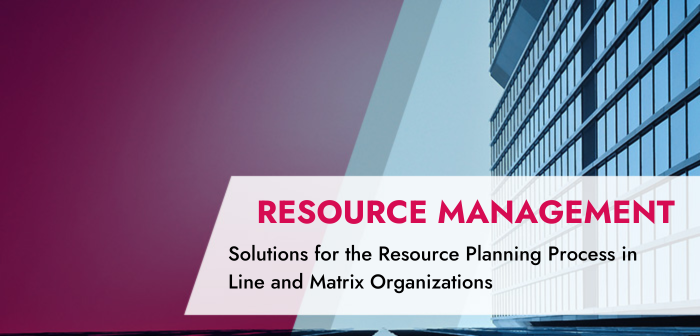Which resource planning process do you need to ensure that the allocation of resources to projects works efficiently? What requirements does the process need to meet? The most important basic rule up front: the resource planning process must adapt to the form of organization at your company, and the necessary coordination must take place at defined intervals.
This article will outline the specific requirements matrix and line organizations place on the resource management process and how to define the right planning cycle that suits your form of organization. You will learn more about the following topics:
- Requirements for the coordination process between project and line managers
- The solution: a suitable planning cycle
- The resource planning process in the line organization
- The resource planning process in the matrix organization
- Conclusion – Resource planning process
Let us begin!
Note: By tactical resource planning, we mean the coordination between project and line managers. This is dependent on the company’s form of organization (matrix or line). The goal is to meet the project resource requirements by providing the necessary skills in a timely manner using the line staff. This tends to be the team leaders’ responsibility.
What is Project Resource Planning?
Definition: Resource planning in project management – aka project resource management – is a key element of project management. It ensures that a project has access to the necessary resources (staff, facilities, etc.) at all times. This planning is very closely related to the development of schedules and budgets.
Resource planning is an important part of project management because:
- Project resource management helps a company reach its targets by focusing on optimization and efficiency.
- The goal of every company is to achieve its objectives with as little effort as possible.
- Knowing what you need for the project to be successful lets you plan effectively and make economic use of the available resources. Larger companies often have a resource manager specifically for this purpose. This person relieves project managers of tasks such as organizing the necessary resources for already planned projects from the team leaders involved.
What is the resource planning process?
Resource planning process refers to the workflow used for resource management and includes the process cycle, the arrangements for coordination between project and line managers and the use of tools for this purpose.
Requirements for the Coordination Process between Project and Line Managers
Project managers need the resource commitments from the line managers as fast as possible because they need these commitments to plan their projects. Naturally, these commitments should still be truly reliable. How can this be achieved?
Given these constraints, the challenges for team leaders are:
- Multiple project managers will send repeated requests to the same team leaders at different times
- This hinders the team leaders from having a stable basis for their decisions
- Yesterday’s carefully coordinated plans may be obsolete today already due to a new incoming request
- Team members are often assigned responsibilities outside of projects. This affects productivity in the projects.
The Solution: A Suitable Planning Cycle
The key to success for the resource planning process is to agree on a planning cycle. This can greatly help facilitate the resource planning process.
The length and duration of the cycle should be aligned with the lifespan of projects at your company. The organizational effort for planning and coordination needs to remain within reasonable limits over the long term.
Here is what matters:
- The longer the cycle, the more stable the system
- Too long also means too rigid
- Cycles between one and four weeks are customary and useful
We recommend starting with a monthly cycle. This will ensure acceptance without overwhelming the organization. Only shorten the cycle once the system works and if the dynamics require it.
Our tip: Start with a monthly planning cycle. This will ensure acceptance without overwhelming the organization. Shorten the cycle to 2-3 weeks once you know that the system works and if the dynamics require it.
What to Consider for the Resource Planning Process
Get everyone involved to agree that PM resource plans for the current and the upcoming cycle can only be changed under exceptional circumstances. The use of resources should only be rescheduled for subsequent cycles.
This will save the company a lot of coordination effort because you will not have to deal with constant changes. Instead, rescheduling only happens at fixed intervals.
Another interesting read: The Challenge of Project Resource Management
This approach requires all the participants to work harder at coordination. Ad-hoc changes only happen as a last resort. The implementation efficiency will be promoted because all staff members can work without interference for a longer period of time.
The figure below shows this type of process cycle at the levels of the roles involved.
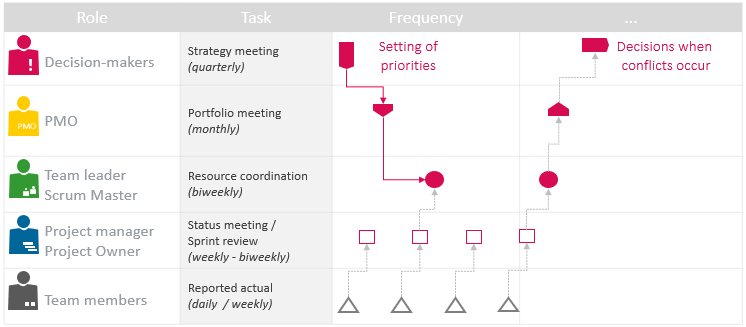
Here is a practical example (see graphic above):
- First, the team members must submit their time tracking reports by Friday.
- The project managers must accept these by Monday night and reschedule the resulting remaining effort.
- This may result in resource conflicts that only become apparent on Tuesday after all project managers have updated their plans (red square).
- The team leaders have until Tuesday night or Wednesday (red circle) to resolve any conflicts. It is essential that the priorities are aligned with the strategy. Remember that those involved need to understand the strategy so that it can be considered here.
- Finally – depending on the PMO (Project Management Office) competencies – there will be a meeting with a steering group / top management in which the resolutions are passed for all remaining decisions resulting from conflicts.
According to our PMO Survey, more than 50% of the PMOs questioned are already involved in “Resource allocation and conflict resolution” or are planning to establish this PMO function in the near future, see figure below. Resource management is also among the PMO responsibilities the respondents desire to expand in the future.
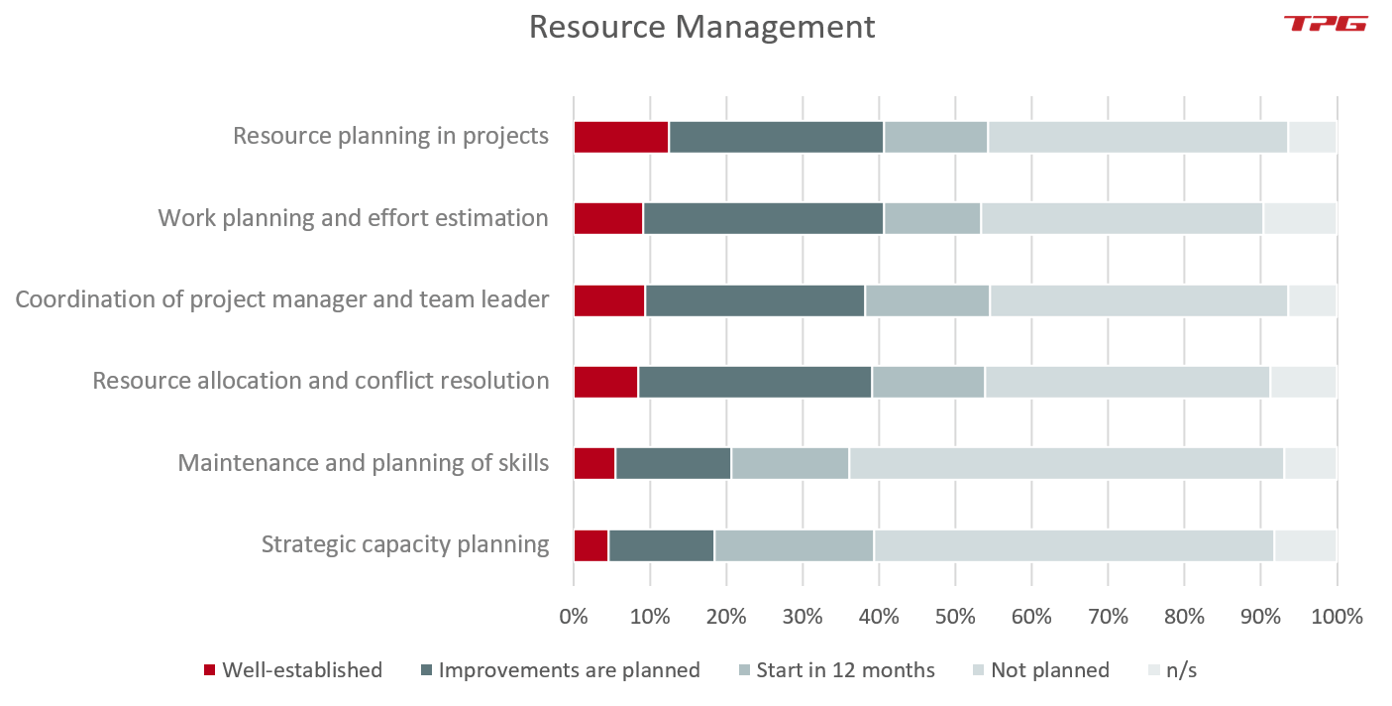
Our tip: Get everyone involved to agree that project resource management for the current and the upcoming cycles can be changed solely under exceptional circumstances. The use of resources can only be rescheduled for subsequent cycles.
Below, you will find out how the process of resource planning differs between line and matrix organizations.
The Resource Planning Process in the Line Organization
In the line organization, the negotiations are not about people but rather the deadlines for deliverables. The project managers plan which deliverables they need by what date. They forward these requirements to the team leaders.
The detailed planning is done by the line managers. The project manager is not involved in resource planning at the level of individual staff members.
Project managers in the line organization are mainly involved in coordinating the scheduling of projects and sub-projects or work packages. Resource coordination takes place within line departments / teams. The team leader is responsible for this.
Subscribe to the TPG Blog Newsletter now and never miss another blog post.
In this environment, stable process cycles and traditional PM tools enable multiple projects to be managed transparently and can produce very good results.
In a line organization, team leaders can also use PM tools. These help them create detailed plans involving factors such as tasks and times (including absences) for their team as shown in the figure below.
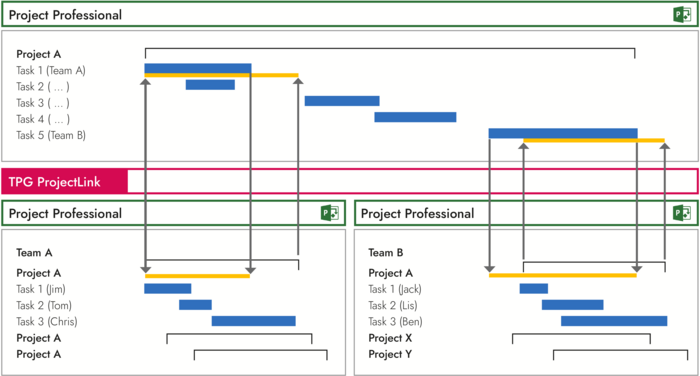
In addition to project tasks, it is also possible to manage the team’s operations using the project plan. This means that the team leader only has to maintain one plan because it also includes all the team’s tasks:
- Project-related tasks
- Absences
- General operations
- Individual operations
Special Download: Resource Planning Software for the Roles Involved (PDF file)
Please fill in the form.
* Required Fields | Data Protection
The Coordination Process in the Line Organization
The coordination process in a line organization looks roughly like this:
- The project managers plan approximate work packages – without the details or resources but with the planned efforts / budgets.
- The project managers forward their rough plans / milestones to the team leaders.
- The team leaders integrate these rough plans / milestones into their own plans.
- The team leaders break down the work packages into individual tasks in their own planning. Next, they assign these tasks either only to people in their own team or also to external resources.
- The team leaders’ planning can be checked against the project managers’ at the level of work packages with regard to scheduling and efforts (see yellow bar on the left in the figure above).
- The variances are visible on both sides. The project manager and the team leader need to discuss these variances to coordinate and eliminate them.
It is vital that the project manager and team leader each use their own planning. In a separate step, the two plans are checked against each other.
Our tip: Make sure that the people in these roles are not able to change each other’s data! Protecting the autonomy of each person’s data enables project managers and team leaders to plan independently. Nonetheless, there should be a technical link between the team leader’s and the project manager’s plans to enable the sharing of data. This can be used to coordinate the use of resources.
The Resource Planning Process in the Matrix Organization
The matrix organization is a different thing altogether. Traditionally, project managers plan their projects with detailed tasks. They then assign these tasks to people or skills (generic resources).
The team leaders or the respective teams are the ones who decide which people are committed to them and to what extent. The team leaders must consider all the requests from different project managers, as well as the absences and operations, to explore the possible commitments.
However, it usually makes little sense to make these commitments at the individual task level. As a rule, team leaders do not need to know which exact tasks have been assigned to their team members. They are more concerned with which team member is working on what projects – and when. For this, it is enough to have the project managers coordinate this at the project level.
Looking to introduce resource management? Here is how to do it fast and well.
Team leaders in a matrix organization have the undesirable task of handling commitments of the required resources for different projects.
In most cases, traditional project management tools are inadequate for handling this. Why is this? Because the team leaders’ commitments are not maintained as an individual data pool. They are normally only marked with the status of the project or task.
The inherent problem: Postponements can occur in a project. If this happens, the staff commitments (which are only assigned a status) are simply postponed along with the tasks. However, team leaders only commit staff resources for designated periods of time.
This is logical because these same resources also need to work on other projects. For this reason, postponements usually result in resource conflicts, which spark new discussions (and require additional coordination).
For the coordination, the project manager and team leader need to maintain their own planning data at the project level. These need to be compared (see figure below).
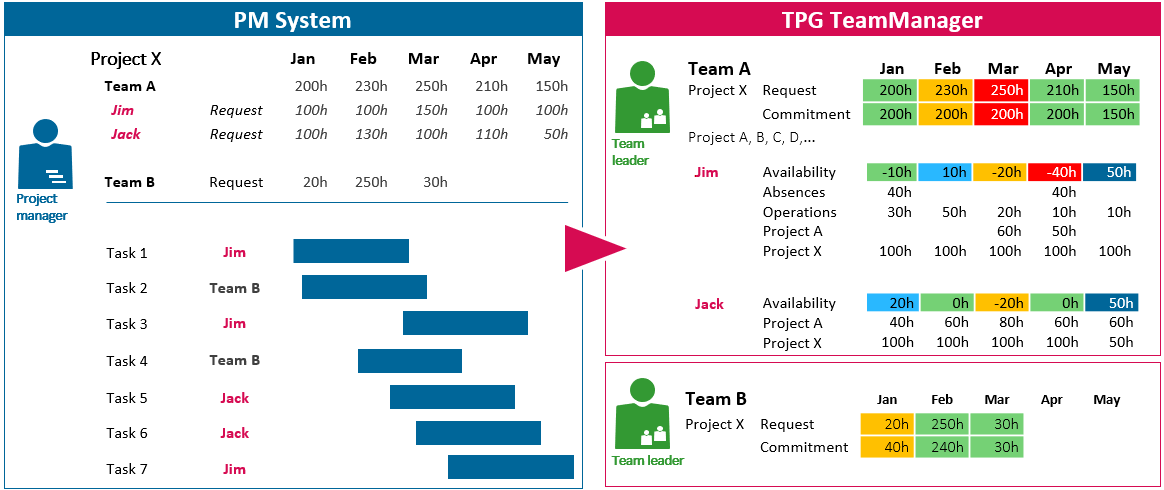
If there is only the project managers’ plan, the team leaders are completely “at the project managers’ mercy”, at least in terms of the data. They can suggest ways to resolve the conflicts, but this will not change the project managers’ plans.
Neither can they negotiate with all project managers at once.
To be able to make commitments to the projects, team leaders need to first plan the absences and operations. They can only determine the real availability of a team member for the project on this basis.
Our tip: A resource management tool created especially for team leaders and supporting all requirements for successful resource coordination between project and line management in the matrix organization is the optimal support for this case.
Free Download: eBook “Tactical Resource Management” (more than 80 pages)
Resource planning between project managers and team leaders is always a challenge in project management. In this free eBook, you will learn how meeting this challenge can become easier.
> Click here to download your free copy of the eBook.
The Coordination Process in the Matrix Organization
This is what the project resource management process in the matrix organization looks like:
- The project managers plan their projects in detail at the task level.
- The project managers assign either people or skills to the tasks.
- The team leaders determine the project availability of their team members from capacity minus absences and operations.
- The team leaders analyze the resource requests from the different projects. They commit their team members for available periods of time.
- The project managers incorporate these commitments (as time frames) at the project level. Within these time frames, the project managers have flexibility in planning the tasks.
- By comparing both roles’ planning, variances become visible. This provides a good basis for direct discussions to coordinate the efforts.
Our tip: Ensure team leaders in a matrix organization have their own planning in which they also manage absences and operations. This enables an accurate evaluation of the availability and gives project managers the confidence to rely on the resource commitments.
Conclusion – Resource Planning Process
This article has described the resource planning process in project management. It has also shown how the processes are shaped by the organizational structure. You are now familiar with the coordination processes for line and matrix organizations.
For both forms of organizational structure, make sure that you establish adequate process cycles. Your team leaders cannot respond to resource requests for the coming week several times a day. You need to gather requests for the cycle after next, as well as the subsequent cycles, over the period of the current cycle. Responses to the requests are only required by the due date.
Ensure that the commitments for the current cycle remain as stable as possible. Changes should only be permitted under exceptional circumstances. This approach makes resource coordination reliable for all involved.
Our final tips:
Get to know the individually adaptable “PPM Paradise” – the optimal environment for your enterprise-wide project, program, portfolio and resource management (PPM). Download the free eBook “The PPM Paradise” now (just click, no form).
And sign up for our bi-weekly blog newsletter with information on more hands-on articles, eBooks, etc. to improve your project management maturity level.
Have you been involved in establishing a resource planning process? Do you agree on the importance of stable process cycles? Please leave a comment below.
Johann Strasser
Managing partner at TPG The Project Group
The certified engineer, has been a managing partner at TPG The Project Group since 2001. After many years as a development engineer in the automotive and energy sectors, Johann Strasser spent a decade as an independent trainer and consultant in the field of project management. During his tenure, he also served as project manager for software projects in the construction industry and provided scheduling and cost management support for large-scale construction projects. At TPG, he applies his expertise in product development and consulting services for international clients. His special focus is on PMO, project portfolios, hybrid project management, and resource management. For many years now, he has shared his knowledge through presentations, seminars, articles, and webinars.
You can read more about Johann Strasser on LinkedIn and XING.
 Achim Schmidt-Sibeth
Achim Schmidt-Sibeth
Senior Marketing Manager
After earning his engineering degree in environmental technology, he gained many years of experience in project management through his work at an engineering office, an equipment manufacturer, and a multimedia agency. Achim Schmidt-Sibeth and his team have been responsible for content marketing and communication at TPG The Project Group for many years now.


